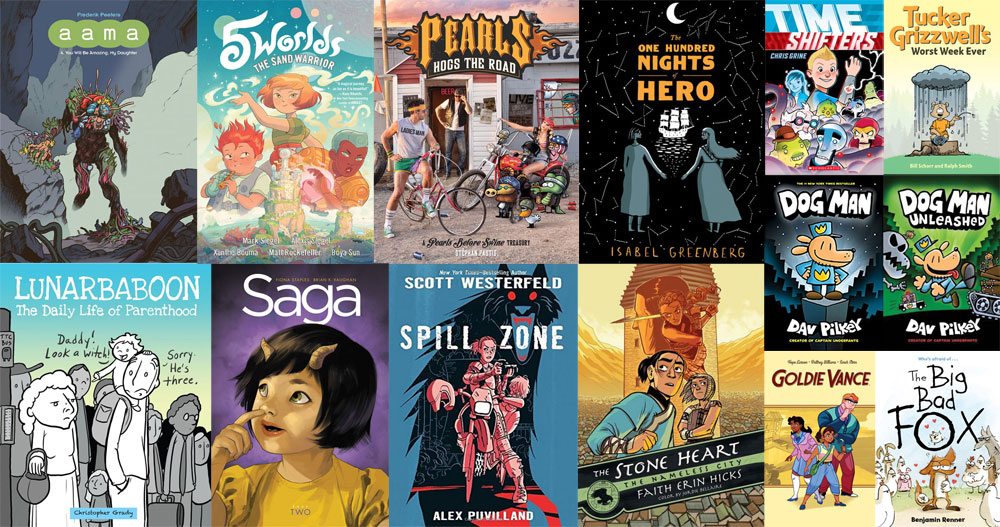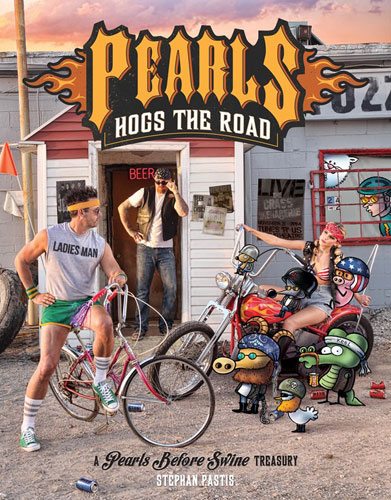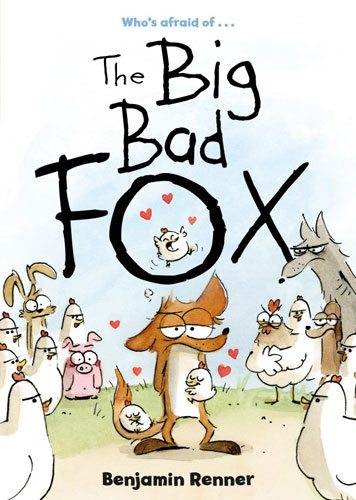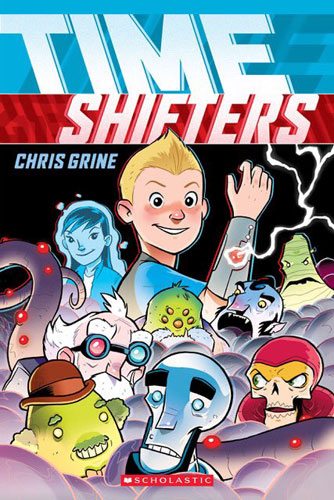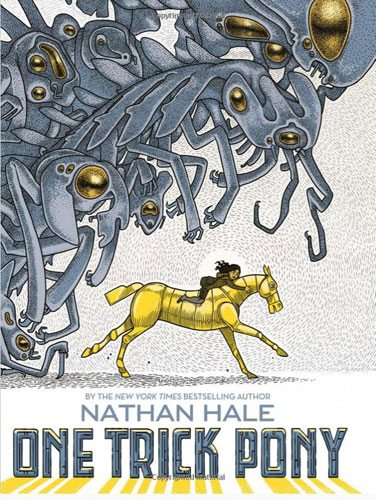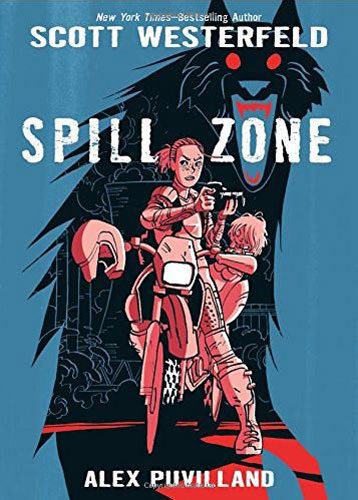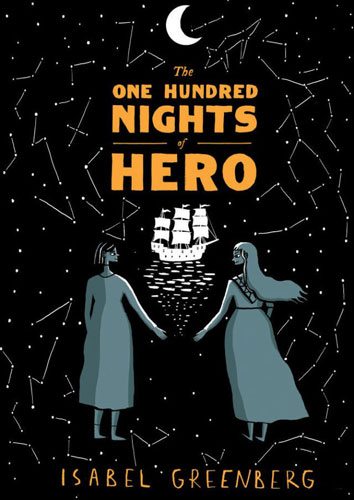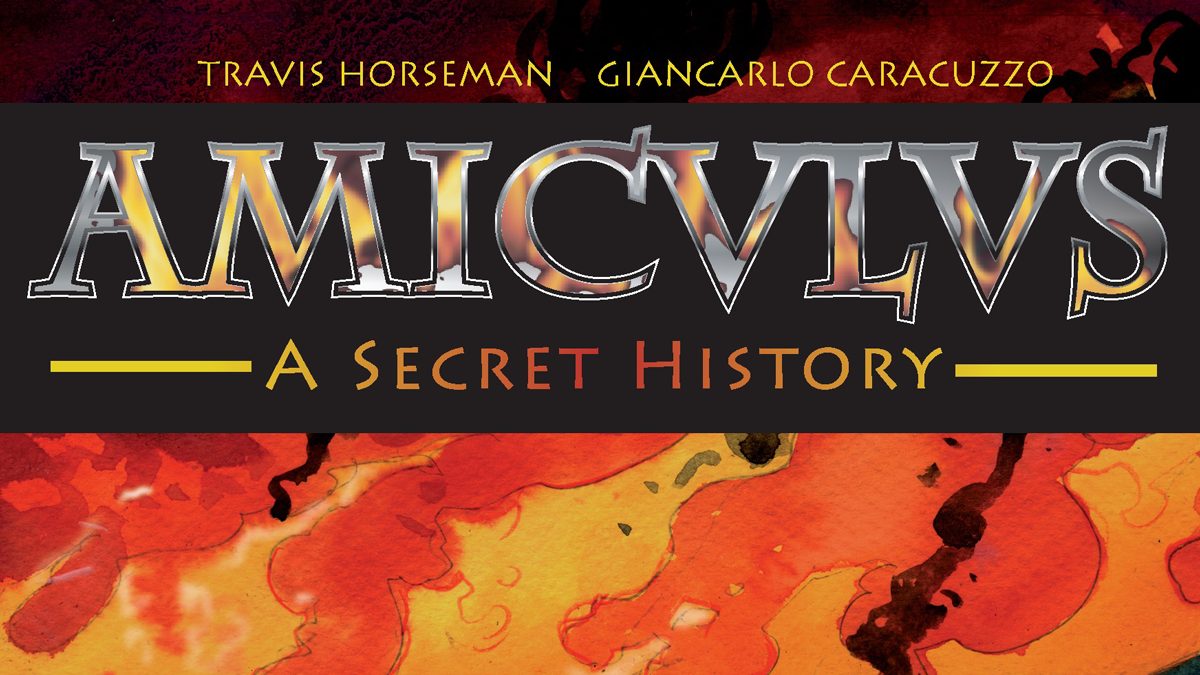In the correspondence pages to The Unbeatable Squirrel Girl, Ryan North is fond of saying that comics are a medium, not a genre, and I agree! For many people who haven’t read many comics, there’s often the idea that “comic book” means only superhero stories—but of course comics can be used to tell a whole host of different types of stories, from the funny to the profound to the disturbing. North gives the example that if the only movies you’d ever heard of were romantic comedies and you didn’t like rom-coms, you might think you didn’t like movies. Today’s Stack Overflow is a collection of comics that run the gamut—from kids’ stuff to adults-only.
Dog Man and Dog Man Unleashed by Dav Pilkey
Dav Pilkey is well-known for the Captain Underpants series, which are a mix of cartoony illustrations and prose. Dog Man is a comic book all the way through (with a few Flip-o-rama sequences). The idea is that George and Harold (from Captain Underpants) created the Dog Man comics when they were younger, and have now remade them with better spelling and drawings—but they still look like kids’ drawings and handwriting. The premise of Dog Man is that officer Knight (super tough, but not too bright) and police dog Greg (smart, but … he’s a dog) were in a terrible accident, and to save them, the doctors sewed the dog’s head onto the man’s body, turning him into the greatest cop ever. Dog Man is constantly foiling his nemesis, Petey the Cat, and having crazy adventures.
The series is targeted at elementary school kids, and has a lot of very silly humor in it. Pilkey himself struggled with dyslexia as a kid, and found motivation to read through funny books, particularly those with illustrations to give him more context for the words—so Dog Man is his way to pass on his love of reading to kids, as well as encouraging them to create their own stories like George and Harold do.
Tucker Grizzwell’s Worst Week Ever by Bill Schorr and Ralph Smith
The Grizzwells is a long-running comic strip that appears in newspapers (kids, ask your parents) and online, about a family of bears. This book is actually a continuous story rather than a collection of individual strips, about a week in the family’s life, told mostly from Tucker’s point of view. His dad is excited about taking him to the upcoming rite-of-passage “Jaws and Claws” weekend, where Tucker will be taught all the necessary skills to survive in the wild—like dumpster-diving, stealing food from campsites, and so on. Tucker, on the other hand, just wants to be an astronaut. Although the book has an overarching plot, the whole thing is peppered with little one-liners and—I gotta warn you—a lot of dad jokes. If you and your kids like the humor of The Grizzwells, then you’ll enjoy this longer tale about the family. But if puns and goofy jokes just make you groan, you might want to pass.
Pearls Hogs the Road by Stephan Pastis
Speaking of puns, the latest collection of Pearls Before Swine has a ton of of them, as fans of the strip know well. This book collects the daily strips from March 2014 to September 2015, with commentary on many of the strips from Stephan Pastis. (I’m a little curious why it takes so long to print a collected volume, but maybe it’s writing all that commentary while maintaining the daily strip.) In case you’re not familiar, Pearls Before Swine features various talking animals (and people), including a mean Rat and a dumb Pig, and many of the strips are long setups for particularly excruciating puns. Pastis also prides himself on how much he’s able to get away with in his strips—remarking many times on things that can now appear in newspapers that would once have gotten his strips rejected. (I’d say the strips are a bit more risque than some other newspaper strips, but not so much that I don’t let my kids read them.)
One particularly notable series of strips in this volume originally ran in June 2014. I wrote about them at the time, but it was fun to see them again while reading this book. The short story is that Bill Watterson (yes, that Bill Watterson) came out of retirement to illustrate a few Pearls Before Swine strips, which is pretty amazing. If you like puns, self-deprecating humor, and comics that break the fourth wall, Pearls Before Swine should be on your shelf. Or—in our case—always on the dining table, open to whatever page my daughters happen to be on.
The Big Bad Fox by Benjamin Renner
This is a delightfully funny story about a fox who gets no respect. He raids the farm daily, gets beat up by the chickens, and then settles for a couple turnips that the pig helpfully digs up for him. When he and the wolf hatch a plan to, well, hatch some eggs themselves for a nice meal, the fox suddenly finds himself acting as the mother figure for three little chicks. Renner, who worked on the film Ernest and Celestine, gives wonderful expressions to the various animals. The fox’s machinations are reminiscent of Wile E. Coyote (kids, ask your parents), and his run-ins with the chickens are hilarious. The Big Bad Fox will be released in early June, so keep your eyes out for this one.
5 Worlds: The Sand Warrior by Mark Siegel, Alexis Siegel, Xanthe Bouma, Matt Rockefeller, Boya Sun
5 Worlds is a new all-ages fantasy series headed up by Mark Siegel, the founder of First Second Comics. The five worlds are a planet with its four moons, which were once a single empire before the moons claimed their independence. Each of the worlds has a giant beacon, placed there by the ancient Felid Gods, but nobody knows what they’re for. Oona is a sand dancer on Mon Domani, the mother world—she’s learning to manipulate and control a sand animus, but hers always gets away from her and wreaks havoc. An attack on the planet throws her into the company of An Tzu, a kid from the slums with a mysterious ailment; and Jax Amboy, a beloved sports star who has some secrets up his sleeve.
The book is beautiful, with a vast array of characters and creatures from the various worlds. I like that the book is an engaging and sometimes whimsical fantasy story, but there are also some intense scenes. It also touches on issues of inequality and prejudice that can be starting points for conversations with your kids. This book is just the first in the series, so we’re just getting to know the characters, but I can’t wait to see what happens next.
As you know, I’m a huge fan of time travel stories (see here, here, here, and here) so I’m always on the lookout for more. This kids’ comic has a time travel element, though most of the story is shifting into another world rather than just another time. Luke loses his big brother one day when a bully’s prank goes too far—this introduction to the story was a bit of a shock—but then shortly after he comes into possession of a strange device dropped by some strange characters in the woods. He ends up in the company of a scientist, a robot Abraham Lincoln, a ghost, and a dinosaur, who are on the run from some of the strangest bumbling henchman you’ve ever seen.
The story itself, despite the rocky start, is a pretty hilarious romp through bizarre worlds, and along the way Luke makes some discoveries about both the benefits and the downsides of being able to change the past. I don’t know if there will be more Time Shifters in the future, but the book leaves it open for more adventuring across time and space.
Nathan Hale does a lot of middle-grade comics based on historical events (that’s a whole ‘nother genre comics can handle!) but this one is pure fiction: a post-apocalyptic world in which aliens called Pipers have taken over the planet, sucking up electrical devices and blowing bubbles that cut through matter. Strata’s family is part of a city-on-wheels that is trying to rescue as much digital technology as possible to preserve human knowledge; when she and her brothers come across a robot horse, Strata insists on keeping it despite the danger it will attract.
I came across this one at the bookstore and was really intrigued by the creatures on the cover, so I bought a copy. It’s not too long, but is a really fun adventure. The illustrations are done in black-and-white-and-yellow, which really makes the gold pony and the Pipers’ eyes stand out, which is a cool effect. The aliens are bizarre, and the reveal of what they’re actually after is pretty creepy—though not so much that I think kids wouldn’t enjoy the book.
The Stone Heart by Faith Erin Hicks
This is the second volume in the Nameless City series, and it’s a little harder to pin down the genre. It’s not exactly fantasy, at least not yet—there’s nothing in the story that is explicitly unreal, though there are hints of a great weapon that the founders of the City once had. It remains to be seen what that weapon turns out to be. The architecture and culture is inspired by 13th-century China, but it’s not historical fiction, either. Hicks has created a tale of friendship, political intrigue, and adventure. It digs into a lot of issues—both good and bad—surrounding a city that has residents from many different places living together. (I mentioned it in this Stack Overflow, and both GeekMom Rebecca Angel and GeekDad Jamie Greene have interviewed Hicks as well.)
In this volume, the General of Swords, leader of the Dao, wants to give all peoples a seat at the table—but his son, Erzi, is unhappy that he will not be the next ruler of the Nameless City, and decides to take things into his own hands. Meanwhile, Rat has information about a great weapon—but her knowledge may put many people in danger. We also get some more background on Mura, a Skraal woman who is Erzi’s bodyguard. This is another series that I’m really enjoying.
This series is appropriate for tweens and up—there are some scenes of violence and war, so it’s not for little kids, but it’s also not too explicit or gory. Mostly the story focuses on the two kids at the heart of the story, Kai and Rat.
Goldie Vance by Hope Larson, Brittney Williams, Sarah Stern
Goldie Vance is about a teen sleuth—Marigold Vance, who works at a Florida resort with her dad. She wants to be the hotel’s in-house detective, but really she’s supposed to be parking cars. When a mystery comes in that Walter can’t figure out himself, Goldie dives in—and gets mixed up in a mystery that’s bigger than she expected. The story is set in the 1960s, and part of the plot in this first volume references the Space Race between the US and Russia, though it’s been fictionalized quite a bit. Goldie is a really spunky heroine, and there’s a fun cast of characters in her Scooby gang. I like that the cast is diverse, and the story itself is a mix of action and mystery. I’ve just read the first volume so far, but the second volume was just released this month so I’ll have to put that on my list.
Goldie Vance is also one that I’d recommend for tweens and up, or perhaps middle grade readers. There is some fighting, along with car chases (and crashes), but nobody gets too terribly hurt, at least in the first book.
Spill Zone by Scott Westerfeld and Alex Puvilland
A disaster turned upstate New York into a bizarre quarantined zone, populated by twisted creatures and inscrutable physical laws. The only people left inside are “meat puppets,” floating around in the air but not really alive. Addison Merritt sneaks through the perimeter to take photographs inside the Spill Zone, selling them at a high price to collectors so she can take care of her little sister Lexa—her parents were in the zone when the disaster struck. Lexa doesn’t speak at all—at least to Addison. It turns out she has some secrets of her own.
Spill Zone is the sort of sci-fi that reminds me a little of Neil Gaiman and Nick Harkaway fiction: it’s not traditional sci-fi, but portrays a world in which there are some things that are just off. There’s a weirdness, and maybe there are rules to how things work, but you and the characters don’t know what they are. This volume just kicks off the story, and there’s definitely more to come—I’m really looking forward to seeing what comes next.
I’d consider this one a YA graphic novel simply because of the eeriness of the zone.
Lunarbaboon: The Daily Life of Parenthood by Christopher Grady
If you’ve never heard of Lunarbaboon, you should check it out now. Grady’s comic strips portray life as a dad in a way that is honest and funny and often subversive. He turns tropes on their heads, while still showing that sometimes your kids are awful and the best you can do is just tell everyone else so you can all laugh about it together. It’s adorable and sweet and also contains a lot of swear words, just as a warning. This book is a great collection of the Lunarbaboon strips, and is great reading for parents who need a little perspective and humor about their lives.
The One Hundred Nights of Hero by Isabel Greenberg
One of my favorite comic books of 2013 was The Encyclopedia of Early Earth by Isabel Greenberg, a collection of stories that feel like folktales passed down through the ages, though with some modern sensibilities, too. One Hundred Nights of Hero is set in the same world, and is Greenberg’s own version of Scheherazade’s 1,001 nights. A wager between two men results in one of them trying to seduce the other one’s wife—who, as it turns out, is actually in love with her maid, Hero. Both Cherry and Hero realize that the man plans to have his way with her, one way or the other—either because she relents, or in spite of her resistance, and will then report to the husband that his wife was unfaithful. The solution, then, was to delay the inevitable by telling tales—Hero shared the stories she learned from her own mother, mesmerizing the would-be suitor until the 100-day wager was up and the husband returned home.
As with Early Earth, the tales in this one are interrelated, with characters from one appearing in another. There are some stories that seem familiar—one is based on the Twelve Dancing Princesses, but takes a different turn at the end—and others that were new to me. The One Hundred Nights of Hero has some fairly sharp commentary about the role of women: in the stories, the women who can read and write are considered witches, and they’re treated as property or prizes (as they often are in many fairy tales), but in Greenberg’s versions they have a self-awareness about it and work to change how things are. The book feels like fairy tales for grown-ups, with a new set of lessons to learn.
Aama 4: You Will Be Amazing, My Daughter by Frederik Peeters
I’d mentioned the first three volumes of Aama in previous columns, and then somehow when I received the fourth (and final) volume, I misplaced it and just came across it recently. This series is really weird—sort of a psychedelic sci-fi about a strange biotech experiment. In this volume, Verloc Nim has merged with Aama, making him a strange hybrid of the man he once was and the explosion of biological life that Aama causes. (That’s him on the cover there, with plant-like life sprouting from him and from whatever he touches.)
Although I’ve read the whole series now, I have trouble really explaining it concisely, other than that you can really immerse yourself in this surreal world. There are manipulative corporations, and otherworldly powers, and the love of a father for his daughter. Definitely one for adults who are okay with a story that may raise more questions than it answers.
Saga Book 2 by Brian K. Vaughan and Fiona Staples
I’m late to the party as usual with Saga, a fantasy space opera comic series. I didn’t read it at all until the first hardcover collection came out in 2014. And then, since I’d bought the hardcover, I didn’t want to buy all the monthlies or even the trade paperbacks because I wanted to get Book 2 in hardcover as well … which meant I had to wait until this month, when it was finally released. I picked up a copy at the bookstore, and then I sat down and binged it in one day, staying up way too late to find out what happens with Hazel and her parents.
Saga is definitely for adults only—it has profanity, violence, and sex—but it’s also an amazing story about being parents. There’s a bit of a Romeo-and-Juliet vibe, since Marko and Alana are from two worlds at war with each other. Both sides want them dead because neither can admit the other’s humanity, and little Hazel is evidence of their impossible love. The story digs into tough topics: racism, war, inequality, sexuality, abuse, and more, but in a way that also includes crazy alien worlds and relentless contract killers and grandmas with prison tats. I really think it’s one of the best comics series I’ve ever read. I don’t know if I’ll be able to wait another 2.5 years for Book 3 before finding out what happens next, because there’s a killer of a cliffhanger at the end of this one.
The hardcover collection really showcases Fiona Staples’ amazing artwork, though you don’t get the letters pages from the monthly comics, which is a shame. However, this one also includes a gallery of Saga artwork by other artists like Faith Erin Hicks and Todd McFarlane and Pia Guerra. If you haven’t read any Saga yet, there’s five years of it to enjoy! (Well, three years if you decide to go the hardcover route.)
One genre I haven’t covered much in this column is non-fiction—there are a lot of fantastic non-fiction comics out there, both for kids and adults, and comics can be a great way of communicating a lot of information in a compact form. I’ve got a bunch sitting on my shelf even now, so I’ll share those later on!
